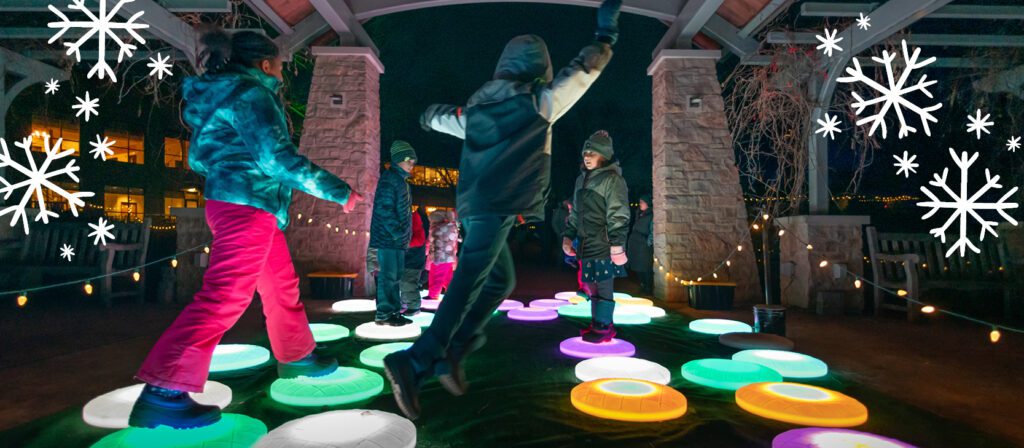There are many water-loving plants in the stormwater basin below.
Scientists call them “aquatic” plants.
Can you find these native Wisconsin aquatic plants down below?



Juncus effusus



Bolboschoenus fluviatilis



Pontederia cordata



Sagittaria latifolia



Small roots that help the plants get
more oxygen and nutrients.



Spaces in their stems, roots, and leaves that help air move around.
Flora in the Flow
The Lily Pad Splash Play area celebrates plants and animals in the food webs found in Wisconsin waters, including cattails, dragonflies, frogs, turtles, and birds.
Aquatic plants can have other adaptations to survive in water, such as stems that easily bend with water movement, strong roots to anchor them, and floating leaves to gather more sunlight.
There are more than 100 species of aquatic plants in Wisconsin: 12 species of frogs, 11 species of turtles, 160 species of fish, and around 110 species of dragonflies.
Dragonflies spend up to 95% of their life in the water before they become the flying adults that we know best.
Multiple kinds of frogs are able to create a liquid like antifreeze to protect their cells and organs in the winter while part of their body freezes. One of the Wisconsin frogs, the Wood Frog, can freeze up to 65% of its body.
The sculptures of the cattails, dragonfly, frog, turtle, and nest with eggs were created by Brian Wignall of Biodynamics, Inc.
Aquatic plants are essential to the pond ecosystem, they:
Hay muchas plantas que aman el agua en la cuenca de la tormenta abajo. Los científicos las llaman plantas “acuáticas”
¿Puedes encontrar estas plantas acuáticas nativas de Wisconsin abajo?



Juncus effusus



Bolboschoenus fluviatilis



Pontederia cordata



Sagittaria latifolia
Las plantas y los animales tienen rasgos que les ayudan a sobrevivir en su entorno, ¡estos se llaman adaptaciones!
Las plantas acuáticas tienen dos adaptaciones principales:



Raíces pequeñas que ayudan a las plantas a obtener más oxígeno y nutrientes.



Espacios en sus tallos, raíces y hojas que ayudan con el flujo del aire.
La zona acuática Lily Pad celebra las plantas y los animales en las redes alimentarias que se encuentran en las aguas de Wisconsin, incluidas las totoras, las libélulas, las ranas, las tortugas y las aves.
Las plantas acuáticas pueden tener otras adaptaciones para sobrevivir en el agua, como tallos que se doblan fácilmente con el movimiento del agua, raíces fuertes para anclarlos y hojas flotantes para recoger más luz solar.
Hay más de 100 especies de plantas acuáticas en Wisconsin: 12 especies de ranas, 11 especies de tortugas, 160 especies de peces y alrededor de 110 especies de libélulas.
Las libélulas pasan hasta el 95% de su vida en el agua antes de convertirse en los adultos voladores que mejor conocemos.
Múltiples tipos de ranas son capaces de crear un líquido como anticongelante para proteger sus células y órganos en el invierno mientras parte de su cuerpo se congela. Una de las ranas de Wisconsin, la rana de madera, puede congelar hasta el 65% de su cuerpo.
Las esculturas de las totoras, libélula, rana, tortuga y nido con huevos fueron creadas por Brian Wignall de Biodynamics, Inc.
Las plantas acuáticas son esenciales para el ecosistema del estanque, ya que:
920.490.9457
info@gbbg.org
2600 Larsen Rd
Green Bay, WI 54303
Be the first to know about our latest news, upcoming events, programs, and more.
©2024 Green Bay Botanical Garden. All Rights Reserved.


Save $10 with the code NEW2024
Join by June 3, 2024
A donation to the Garden by Dec 31 makes a world of difference. Be part of our growth journey! 🌺


A Garden membership is a meaningful gift for your loved ones to enjoy this timeless treasure and make memories all year long.
Support the Garden and gift a membership today!
Explore nature’s wonders!
Join as a new member by December 3 and receive two Free Daily Admission Passes.


View and bid on hundreds of items like plant containers and hanging baskets, gift packages, outdoor living items, and so much more.
will be moved indoors with limited seating due to Friday’s weather forecast. Tickets are no longer available. We apologize for any inconvenience!
Our ticketing system is currently down. Call our Guest Experience Team at 920.490.9547 to purchase event tickets or online daily admission. We apologize for any inconvenience!